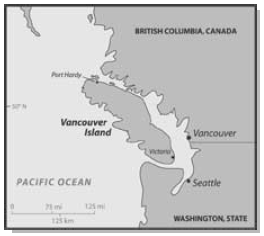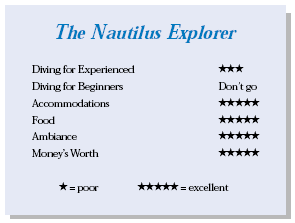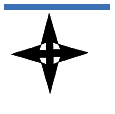The Nautilus ExplorerContents of this Issue: New Dive Destinations, Part II Travel Insurance? Credit Card Refund? Donít Count On It Panic in Recreational Scuba Divers UWATEC Sport Dive Computers Go Dumb Editorial Office: Ben Davison Publisher and Editor Undercurrent 3020 Bridgeway, Suite 102 Sausalito, CA 94965 adventure diving in British Columbia from the August, 2003 issue of Undercurrent
Dear Fellow Diver: Everything came together on the third dive of my trip to the Inside Passage. The Polartec pullover I'd added under my rented dry suit staved off the chill of the 41 degree water. The two-pound weights I'd stuffed in each BC pocket combined with the 34 pounds on my belt to adjust my buoyancy perfectly, and the nearly slack current carried me gently along the chute at Lucan Pass, off Port Hardy near the northeastern tip of Vancouver Island. Visibility was only 25 feet, but since I was drifting alongside a wall teeming with life, who cared? I spotted three-pound Puget Sound king crabs hiding their colorful carapaces in dark little crevices; sea cucumbers the size of my arm lolled about on rocks. A brilliant 3-foot orange sea pen pulsed in the current like a neon sign at dusk. With 1,000 psi left, I ascended to 15 feet where the colors were brighter, and my buddy and I continued to drift. There I came across bright yellow sea lemons so big I almost expected to see signs reading "Home of the Foot-Long Nudi." We surfaced with no one else in sight, but I was confident that Mike Lever, owner and captain of the Nautilus Explorer, would find us. So we inflated our BCs and laid back, enjoying the solitude and watching a bald eagle soar through the densely forested islands that surrounded us. In a few minutes Mike pulled up beside us. Rhian, the deckhand, lowered the side ladder, and I grabbed hold, lifting my feet so she could pull off my fins. Then I climbed on board. The rain -- or "liquid sunshine," as Mike calls it -- had stopped so we had a pleasant 10-minute ride back to the mother ship. I traveled to B.C. in April to see what Jean-Michel Cousteau has called "the best place to dive in the world." I booked a cabin on the 116-foot Nautilus Explorer, which Mike Lever designed and built three years ago as an expedition yacht. Lever's promotional literature says: "These trips are best suited for experienced divers who are in good physical condition and comfortable diving in current and 'cold' water." He's not kidding. The clientele ranged from middle-aged dive shop owners and instructors to an adolescent girl, but all had prior dry suit experience. Three of us from California had recently been dry suit certified, and we were clearly the rookies of the trip. I boarded the ship on a Saturday night in Steveston, a suburb of Vancouver. We spent the first night -- 18 hours -- motoring to the Campbell River area, halfway up the eastern shore of Vancouver Island in the Strait of Georgia. The Explorer was designed to be a comfortable "night runner" with a heavy, stabilized steel hull, and extensive soundproofing. At times forgetting that we were under way was easy. However, the engine noise reverberating through my cabin below decks did keep me awake that first night. I wish I had known about the ear plugs left out in the lounge. Those who'd been aboard the boat previously (about half the passengers), immediately set up their equipment on the 38-foot aluminum skiff on the ship's sloping rear deck. Following suit, I chose a station, set up my regulator and BC on an aluminum 80, and stored my other gear below the bench. For the rest of the trip, all gear except my dry suit remained on the skiff. Mike explained that each dive would have a time limit, due to the tide-related currents. Tides rise and fall as much as 15 feet in the Northwest Passage, creating "rock 'n' roll" currents. So most dives are timed for slack water -- at least in theory. Beyond that, we were free to dive our own profiles and to dive solo if we chose. On deep dives, Lever recommended a safety stop at 60 feet, then another five minute stop at 10 to 20 feet, with at least 500 psi to start. Lever treated us like responsible adults and expected us to behave accordingly.
We also had a life jacket drill, but the flotation devices were stored in our cabins, below decks. The drill was orderly enough, but I could imagine the panic that would result in a real emergency, with people jamming into the companionway to retrieve their vests. He stressed staying hydrated. They have had unexplained DCS hits, which dropped off since he began warning guests to heavy up on water and juices while cutting back on tea, coffee, and booze. The Explorer's liability waiver is a "short form" by most live-aboard standards, but as usual it places the liability squarely on the divers. If anyone was uncomfortable signing it, Lever offered to refund the entire cost of the trip and pay that person's airfare home. When he said, "You're on your own nickel once you leave the ship" to dive, hike on shore, or kayak, there was no doubt he meant business. On the other hand, nobody checked my C-card, although I was renting a dry suit from the Explorer. Throughout the trip, Lever sought consensus on the types of diving we preferred. He asked those with special needs such as limited mobility or medical conditions to see him privately to arrange assistance. His forthright approach seemed to encourage candid responses. Even with the safety precautions, our checkout dive at Walt's Wall was a major bust, especially for me. It started with a briefing in the ship's lounge, which looked like a pajama party, with everyone dressed in their dry suit undergarments. Lever told us he had timed the dive so we could follow the current's flow in one direction until the tide turned, then have a leisurely ride back. But something went wrong with his calculations. Divemaster Kricket helped me squeeze into the Oceaner crushed neoprene dry suit that Lever had reserved for me. It fit pretty well, considering it was "off the rack" and I'm an odd size (42 short). Because the neck seal felt snug, I wore just a Polartec skin underneath. After taking a giant stride from one of the gates, I began drifting briskly past a virtual pygmy forest of white plumose anemones (called metridiums in California). Visibility was 50 feet, and the invertebrate life was more profuse and larger than in California waters. I soon felt cold, however, even after inflating my suit. When I reached 1,500 psi I had to turn back, but the tides didn't cooperate. Kicking into the current with my Scubapro Twin Jets, I had difficulty keeping up with my buddy and his stiff-bladed Mares Quattros. Chilly and winded, I soon got down to 500 psi and decided to rise from 71 feet to safety stop level. But I couldn't vent air fast enough from the valve on my left shoulder and made a barely controlled toes-up ascent, flaring as much as I could to slow my progress. When I broke surface, I floated like a bathtub toy until I could deflate the suit and get my feet under me. Lever spotted me and recommended that I drop back to 10 feet until I used up my air. I descended to a nearby rock and hung on for dear life, rising again with just enough air in my tank to inflate my BC. I scrambled up the skiff's ladder somewhat sheepishly, feeling like I'd just had a trial by ice water. Lever suggested that I skip the night dive planned for the same spot, and I was glad I did. This time, the currents were stronger, and buddy teams became separated in the dark. People surfaced in choppy waters and clung to rocks in hopes that the skiff would find them. It sounded hairy, but the divers marveled at Lever's skill in picking them up. Later, Mike apologized to everyone for the errant currents, which he couldn't explain. No matter how careful the dive plan, these were erratic waters, and it was up to each diver to adjust to the conditions. The following morning I had a better dive thanks to gentler currents at
Plummer Rock. The shoal at 45 feet was drab and populated mostly by sea urchins.
But the wall was festooned with red soft coral and anemones. Lavender-tinted
encrusting hydrocorals reminded me of Monterey, California. Spooky white basket
stars stretched out like skeletal remains. After the dive, the skiff was winched back on board. We rinsed our dry suits under the shower on the dive deck, and some folks threw their fleece undergarments into the nearby dryer. After changing into dry clothes, I dug into breakfast: two different frittatas, hot oatmeal or cold cereal, fresh fruit, homemade bread, and the usual breakfast beverages. All meals were buffet; the dining salon easily accommodated all 22 passengers (two short of the ship's full complement). Lunches might include pizza, sandwiches, or wraps, all served with soup, salad, and fruit. Dinners ranged from Greek-style chicken with spinach moussaka, pocket bread, and rice, to grilled salmon filets with asparagus. Fresh-baked desserts completed each evening meal. Occasionally the cooks, Josie and Kim, were late putting out salad dressings and desserts, but they were so cheerful and accommodating, those little mistakes were easy to overlook. The food on the Nautilus Explorer was among the best of any live-aboard I've taken. Soft drinks were available any time from a tap, and beer, wine, and hard liquor could be purchased at the Salty Dog Bar in the lounge next to the dining salon. A local microbrew set me back $2.25. The comfortable lounge has been refurbished and had a library of books, dive publications, and videos. Several nights we watched old Sea Hunt reruns. In one episode, after Mike Nelson's abalone diving buddy had supposedly been devoured by a bogus-looking killer whale, Mike ranted something like "we ought to wipe them all out!" Hmmm. While we cruised to the Port Hardy area, I marveled at Vancouver Island's scenery, snow-capped mountain peaks shrouded by rain clouds. Thick stands of trees came down to the waterline or to the tops of rocky cliffs. We passed a series of smaller islands, also heavily wooded. Occasionally we saw small settlements with names like Alert Bay. Browning Pass is B.C.'s best-known dive site, and Mike briefed us on the octopuses we could expect to see. Pacific octopuses are enormous -- 10 to 15 feet across -- and I've been waiting to see one for decades. This time we started the dive swimming into a stiff current along Browning Wall, then drifting back. The invertebrate life was colorful, even in the low light of a 7 p.m. dive, but less lush than other sites. And the octopuses? They lived up to their elusive reputation, and no one saw any -- the closest thing was a plump eight-inch cushion star. This trip was filled with gearheads. Most divers wore top-of-the line DUI drysuits, with fleece undergarments in nylon shells to keep lint out of their dry suit valves. Several had trouble with them. Some folks spent entire surface intervals patching tears, but the major problem seemed to be with the seals of "dry" gloves. I wore wet suit mitts and, while my fingers were chilled, I still had all the dexterity I needed. One California diver actually switched back to his 7 mm wet suit. Several used backplates with wing-style BCs. A Russian immigrant named Yevgeny dove with a rebreather and warmed his dry suit with Argon. When a buckle snapped on my Scubapro split fins, Yevgeny lent me his buddy's, since she was sitting out that dive. Kevin, an instructor from B.C., later sold me a replacement strap and buckle combination he'd packed into his save-adive kit. Pretty fortuitous, considering how far we were from the nearest dive shop. Most photographers shot digital, so between dives they didn't fiddle with housings and strobes much. After a dinner of English-style roast beef (translation: overdone), one fellow treated us to a complete PowerPoint presentation of the day's diving on his laptop. Easy, instant gratification: the American dream! We had only three tidedependent dives a day. So between the hot tub, lounge, and dining salon (where snacks, juices, and soft drinks were available all day), there were plenty of opportunities to socialize, read, or nap. The Explorer has nine double staterooms below decks, each with a separate shower and head. A few changes of clothing could be stored in a couple of drawers, and luggage went under the bunks. There was just enough room for two of us to dress at once. An air-conditioning vent over the door supplied fresh air, but it got stuffy. I could see the passing scenery through a porthole between the bunks, but it was sealed tight, so there was no fresh air. Two executive suites on the upper deck are near the hot tub and away from the major traffic flow. At Dillon Rock, we encountered another icon of B.C. diving: wolf eels. These fierce-looking characters are so docile we were encouraged to take off our gloves and pet them. I tried it, and my hand felt no colder with my glove off than on. The wolf eel felt slimy and squishy, even on the top of his head. I also saw a 16- inch octopus, 10 percent the breadth of what I hoped for. Mike put variety into the diving, with a wreck dive on the remains of a Civil War-era paddle wheel gunboat and an old quarry by the shore of Alert Bay, but most of the time was spent on sheer walls or pinnacles. Other than some dolphins playing in our bow wake, we never saw any marine mammals (although Undercurrent reader Nikki Mahan from Bellevue, Washington, reported an amazing encounter with at least 15 stellar sea lions for more than 20 minutes a month after my trip). A Puget Sound diver agreed with the California contingent that we hadn't seen anything in B.C. that we couldn't have seen in California or Puget Sound. However, the size and profusion of the critters, especially the invertebrates, were stunning. To me, the lure of this trip was venturing into an unspoiled wilderness and diving unpredictable waters in sometimes rugged conditions. That said, the Nautilus Explorer provided an extremely comfortable platform, even luxurious by live-aboard standards. The crew was especially helpful and friendly, though most were new and had little diving experience. And a true camaraderie developed. By the end of the trip we had all swapped e-mail addresses, and one passenger, Mike, set up a website so photographers could post their digital images for everyone to share. With all these pluses, the diving was just one part -- and not the highlight -- of a very memorable trip. P.S.: In October and November 2004, the Explorer will move to La Paz, to dive the Sea of Cortez. They will also take trips to the Revillagigedos Islands. It's a super boat for these locations. -- D.L.
|

I want to get all the stories! Tell me how I can become an Undercurrent Online Member and get online access to all the articles of Undercurrent as well as thousands of first hand reports on dive operations world-wide
| Home | Online Members Area | My Account |
Login
|
Join
|
| Travel Index |
Dive Resort & Liveaboard Reviews
|
Featured Reports
|
Recent
Issues
|
Back Issues
|
|
Dive Gear
Index
|
Health/Safety Index
|
Environment & Misc.
Index
|
Seasonal Planner
|
Blogs
|
Free Articles
|
Book Picks
|
News
|
|
Special Offers
|
RSS
|
FAQ
|
About Us
|
Contact Us
|
Links
|
3020 Bridgeway, Ste 102, Sausalito, Ca 94965
All rights reserved.

 They offered Dive Alerts to those who didn't bring them, but they were only to be used in an emergency, so the crew would
drop everything if one were sounded.
They offered Dive Alerts to those who didn't bring them, but they were only to be used in an emergency, so the crew would
drop everything if one were sounded. Two beefy ling cod fought over a hole.This time I got to my safety stop all
right but struggled to remain at 15
feet. I needed to begin venting my dry
suit before ascending. Next time I
added another layer of Polartec for
more insulation.
Two beefy ling cod fought over a hole.This time I got to my safety stop all
right but struggled to remain at 15
feet. I needed to begin venting my dry
suit before ascending. Next time I
added another layer of Polartec for
more insulation.  Diver's Compass: U.S. citizens need a current passport to enter
Canada. ... Steveston, where the Nautilus Explorer docks, is a
$20US cab ride from Vancouver International. ... Driving directions
are on the website:
Diver's Compass: U.S. citizens need a current passport to enter
Canada. ... Steveston, where the Nautilus Explorer docks, is a
$20US cab ride from Vancouver International. ... Driving directions
are on the website: 